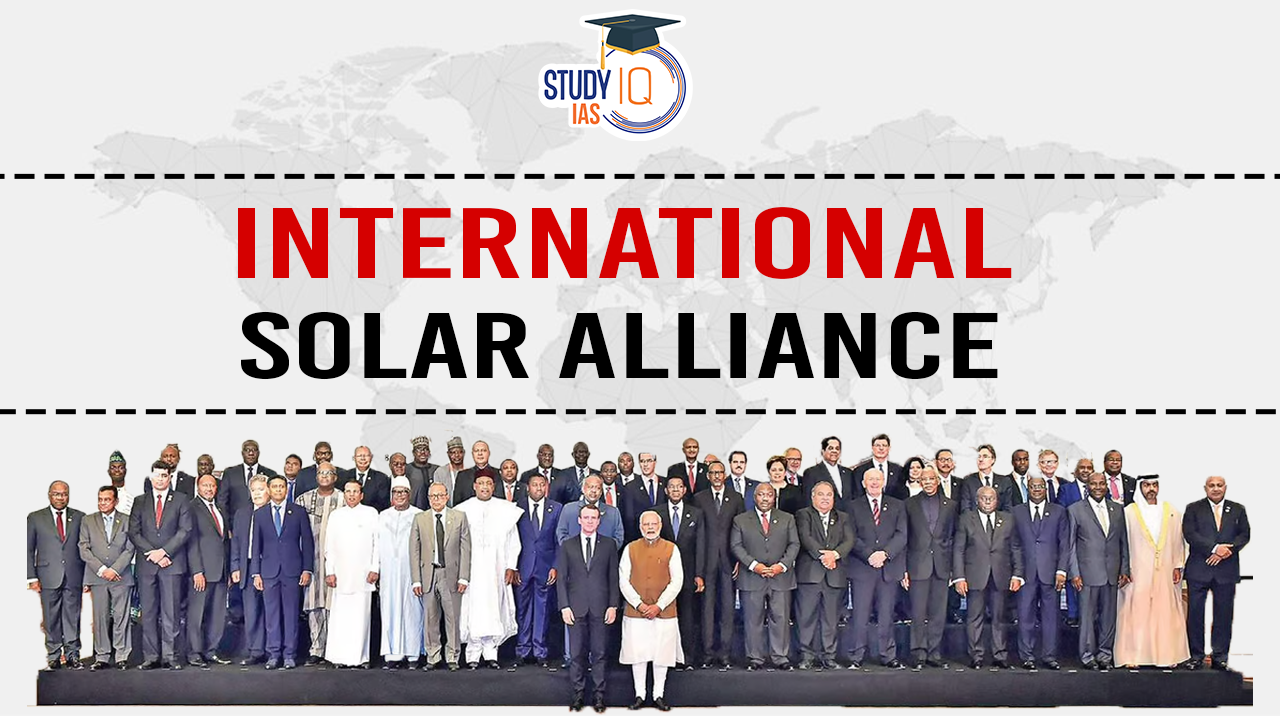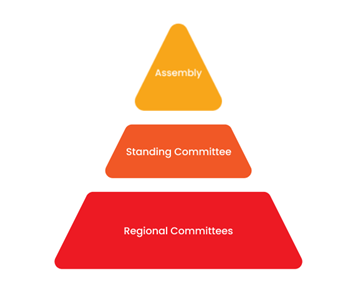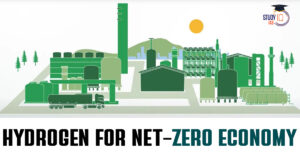Table of Contents
The 7th session of the International Solar Alliance (ISA) Assembly was held in New Delhi. India was elected as president and France as co-president for a two-year term from 2024 to 2026.
What were the Key Discussions in Recent Meetings?
- Global Solar Capacity Growth:
- The World Solar Market Report recorded a substantial increase from 1.22 GW in 2000 to 1,418.97 GW in 2023 in global solar capacity.
- Predictions suggest global solar capacity could reach 7,203 GW by 2030, with solar industry jobs expected to grow to 7.1 million.
- Investment Trends in Sustainable Energy:
- The World Investment Report noted a shift towards sustainable energy investments, which rose from $2.4 trillion in 2018 to an expected $3.1 trillion by 2024.
- Solar energy leads this trend, making up 59% of total renewable energy investments, fueled by declining costs and demand for clean energy.
- Technological Advancements in Solar Technology:
- The World Technology Report revealed advancements, including a record 24.9% efficiency in solar photovoltaic (PV) modules.
- Innovations are reducing silicon usage and lowering utility-scale solar costs, which are essential for affordable and resilient clean energy solutions.
| How the President, Co-President, and Vice Presidents are elected? |
|
International Solar Alliance (ISA)
The International Solar Alliance (ISA) is a treaty-based intergovernmental organisation launched by Prime Minister Narendra Modi of India and Former President François Hollande of France. ISA’s mission is to provide a dedicated platform for cooperation among solar resource-rich countries and the wider global community – including bilateral and multilateral organisations, industry, and other stakeholders – to support the increasing use of solar energy. Launched in 2015 at the United Nations Climate Change Conference held in Paris by India and France.
Objectives of International Solar Alliance (ISA)
To support the addition of 1,000 gigawatts of solar capacity and mobilise over $1 trillion in investments by 2030. It focuses on overcoming political, regulatory, technical, and financial barriers to solar energy deployment by leveraging expertise from technical and financial institutions.
- Develop integrated solar or solar hybrid-based cold chain solutions that bring economic value to farmers and producers, and include the post-harvest in-field technologies that can secure an extended shelf-life of perishable items
- Encourage the use of sustainable, low global warming potential solar-based cooling technologies through financing and incentives for small- and medium-sized farms
- Promote applied research and industry engagement to introduce affordable refrigeration solutions for small- and medium-sized producers with special emphasis on post-harvest processing facilities and transportation.
Important Projects of International Solar Alliance (ISA)
| Project | Description |
|---|---|
| One Sun One World One Grid (OSOWOG) | Focuses on creating a global ecosystem of interconnected renewable energy resources, primarily solar energy, to enable seamless sharing. Aims to ensure continuous access to solar energy across the globe, with economic benefits shared globally. Initiated under the World Bank’s technical assistance program. |
| ISA Solar Technology and Application Resource Centre (ISTAR C) | Establishes a network of technical training, entrepreneurship, research, and innovation centers to exchange best practices, promote knowledge dissemination, and build capacity. Aims to standardize solar applications regionally, facilitate collaborative research and development among member countries. |
| Indian Technical and Economic Cooperation (ITEC) Scheme | Supports ISA by providing solar energy training to master trainers through the ITEC Scheme. Training duration is 21 days, fully funded by the Government of India. In 2018-2019, 133 candidates from 25 countries received training at the National Institute of Solar Energy, Gurugram. |
Achievements of ISA
- ISA has successfully completed 21 out of 27 demonstration projects aimed at showcasing solar power’s potential, particularly in Least Developed Countries (LDCs) and Small Island Developing States (SIDS).
- The organisation has successfully trained nearly 4,000 individuals in solar energy technologies.
Significance of International Solar Alliance (ISA)
- ISA promotes global adoption of solar energy, crucial for combating climate change.
- It fosters international cooperation, facilitating dialogue and collaboration among member countries.
- Through initiatives like OSOWOG, it enables the sharing of renewable energy resources across borders.
- ISA drives economic development by attracting investment, fostering innovation, and creating jobs in the renewable energy sector.
- It enhances energy access and security, particularly in remote and underserved regions.
- ISA facilitates capacity building, knowledge exchange, and technology transfer to advance solar energy solutions worldwide.
Challenges for International Solar Alliance (ISA)
- Financial constraints hinder project implementation, especially in developing nations.
- Policy disparities across member countries impede uniform solar energy deployment.
- Uneven access to advanced technology and expertise poses challenges.
- Inadequate infrastructure, like transmission lines, limits efficient energy distribution.
- Capacity building is essential to address skill gaps and institutional needs.
- Geopolitical tensions can affect international cooperation within ISA.
- Climate-related risks, such as extreme weather events, impact solar infrastructure.
- Public awareness and stakeholder engagement are crucial for project success.



 Hydrogen For Net-Zero Economy, Governmen...
Hydrogen For Net-Zero Economy, Governmen...
 Mantis Shrimp - Latest Research News and...
Mantis Shrimp - Latest Research News and...
 Places in News for UPSC 2025 for Prelims...
Places in News for UPSC 2025 for Prelims...





















